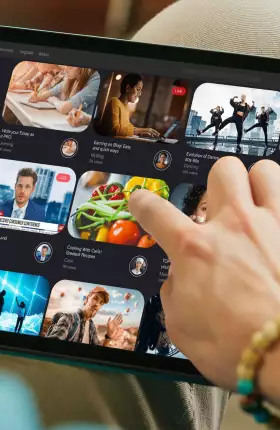Here’s the dilemma facing US subscription video-on-demand (SVOD) providers. Compared with their linear TV counterparts, they have disproportionately thrived during the COVID-19 pandemic. Viewing time is up, as are subscriptions. But heading into the crisis, the over-the-top (OTT) video market was highly competitive—and the competition has only intensified. While all providers have received a boost from consumers under lockdowns looking for entertainment and diversion, the underlying competitive saturation has not changed. And once the US comes out of the crisis, and businesses and schools reopen, consumers will have less time for TV.
Once the US comes out of the crisis, and businesses and schools reopen, consumers will have less time for TV.
The key questions facing SVOD management teams: Who will hold on to their customers gained during the pandemic, and how will they do it? Which services will lose their share of new viewers in the post-COVID reality? Based upon consumer research conducted immediately before and during the crisis, we suggest some steps SVOD providers can take to defend their recently improved positions.
The COVID-19 Surge
Overall video consumption has increased since the pandemic began, and behavior has shifted, with OTT media gaining a greater share of users’ time relative to linear TV. Of the households spending more time watching TV since the crisis began, 54% are doing so on OTT services. Average SVOD subscriptions per household are up by approximately 10%, while the number of AVOD (advertising video on demand, purchased through traditional television providers) services per household has remained stable.
General entertainment, or “core” services, remain differentiated in the market from “niche” SVOD offerings. Before the virus hit, most households had settled on two or three OTT primary services. Four providers—Netflix, Amazon Prime Video, Hulu, and Disney+—formed the core. As of June 2020, their penetration ranged from 65% for Netflix to 29% for Disney+ (at nearly twice the rate of the next-highest service). It is only when households acquire four or more services that the longer tail of niche services—led by HBO, ESPN+, and Showtime—generally begin to pick up subscribers.
Of the pandemic’s total new OTT subscriptions, Netflix has taken 24%, Amazon 16%, Disney+ 15%, and Hulu 14%. While niche services have seen good traction, no single service has gained more than 5% of the total share. This suggests that most households are still watching two to three OTT services and that they have not yet reached the point where they are dipping into the longer tail of SVOD offerings. Of course, if social distancing and self-quarantining continue longer than expected, or if infection rates continue to rise, this pattern could shift as people search for “net new” content.
Another behavior exaggerated amid the pandemic is the sharing of logins, also known as “piggybacking.” The percentage of total users piggybacking onto another’s membership has almost doubled to 26%. At the same time, more than half (56%) of piggybackers say they would be willing to pay for at least one service, an increase of 10 percentage points from 2019.
To Stick or Not to Stick?
It’s safe to say that it’s been a good market for SVOD providers, but the rapid increase in subscriptions during the crisis raises the question of how sticky new subscribers are, or in other words, of how an evolving viral landscape will affect subscriber churn. A big part of the answer is that churn will vary depending on when users acquired their services.
It’s been a good market for SVOD providers, but the rapid increase in subscriptions during the crisis raises the question of how sticky new subscribers are.
Subscriptions purchased during the pandemic have the higher chance of being discontinued: one in five services acquired at this time are at risk of being dropped, compared with one in ten for services owned before (see Exhibit 1). This presents challenges for both core and niche players. Core services, for which a shift of a few points in share has significant revenue consequences, are likely to find themselves in a tough battle with their peers. Niche players face a struggle for viability, and it’s unlikely that all will survive the shakeout, while others will stabilize their footing for the future.
Much of the post-COVID churn will be driven by the simple fact that consumers will not watch as much TV when they return to more regular patterns of activity. While cost is still an important factor for some, with 16% of respondents claiming that to be the case, 36% said they expect to have less time for television. These numbers suggest that subscribers will make choices about which services to keep, and that as long as they have something they would like to continue watching, they’ll continue to subscribe. But competition for consumers’ time will only increase as other aspects of life return to precrisis conditions. SVOD customers will need compelling reasons to stay on.
Hold On to Your Customers
Providers have a critical window right now for persuading subscribers to stick around. Companies that act quickly may be able to retain a portion of their new customers for the longer term, but as normal activity resumes, this window will close. Providers must ask themselves what new behaviors have taken hold in the COVID-affected world and how these new behaviors point toward effective retention tactics.
Presented with a menu of retention mechanisms, subscribers unsurprisingly most often chose those related to price and content (see Exhibit 2). Discounts, free access deals, and a wider selection of movies and TV shows top the list. It’s easy for any company to offer a mix of several consumer incentives.
In our view, however, this moment calls for more than tactical marketing decisions. Given that the challenge in the post-COVID environment is securing market share for the longer term, and since one provider cannot gain share without taking it from another, there is likely to be a reshuffling among core and niche services alike. Management teams should take the time to figure out the incentives likely to work for their particular service. One approach is segmentation.
Management teams should take the time to figure out the incentives likely to work for their particular service.
Our recent research helped us identify distinct OTT viewer types based on users’ current situations and how their lives have been affected by the virus. Each OTT provider may find variations in these segments in addition to other meaningful segments among its user base. It will be worth their while to develop a tailored view of what drives users in order to have a chance at retaining them. Of our segments, four are likely to be susceptible to companies’ attempts to hold on to their business, but the successful retention mechanisms will vary for each.
Younger Users. Largely made up of Gen-Z individuals and millennials, this category captures many users who live in areas that have been hit hard by the virus and who may have lost their jobs in its wake. They are highly receptive to such tactics as highlighting new releases, or OTT-first ones, and to personalized content recommendations.
Regular Cable Users. This group primarily consists of Gen-X individuals, likely settled in their careers and lives, who have between one and three OTT services they usually stick with. They are receptive to personalized recommendations or alerts to upcoming shows that meet their interests.
Homeschooling Parents. These often-exhausted adults have acquired new services primarily to occupy their kids and are therefore likely to churn once precrisis habits return. To retain these users, OTT services should not only think about providing additional kids’ content or bundles— they should also market exclusive content geared toward parents.
Sports Fans. The most frustrated users of all, these fans now subscribe to ESPN+ or to other sports-oriented OTT services, desperate for this type of content. To keep such users from leaving, providers should fill the vacuum with additional (or exclusive) sports content.
Recent times have been good for OTT services. Subscriber numbers and engagement are on the rise, even more so than many would have predicted just a few months ago. But the game is about to get much more challenging. As the pandemic goes on, all services risk increased churn. To get ahead of subscriber loss and maintain the recent surge in share gains, OTT services should target their newest subscribers now and tailor retention tactics by demonstrated preferences and behaviors.














